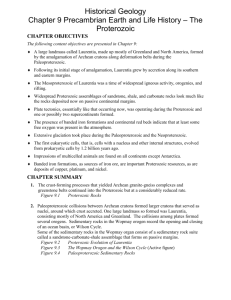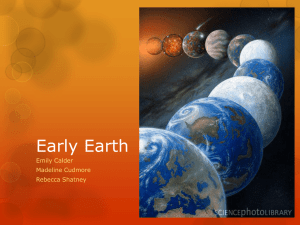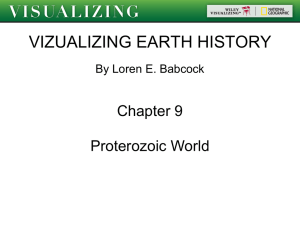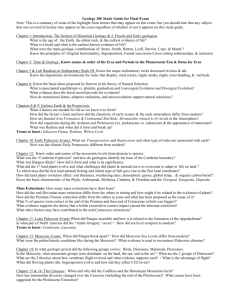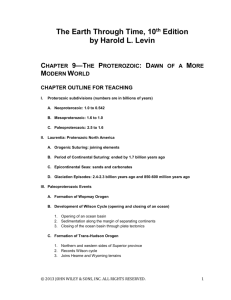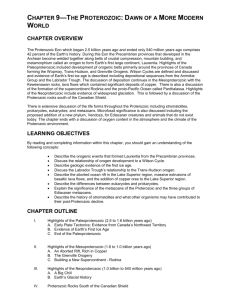CHAPTER 9 - GeoClassroom
advertisement
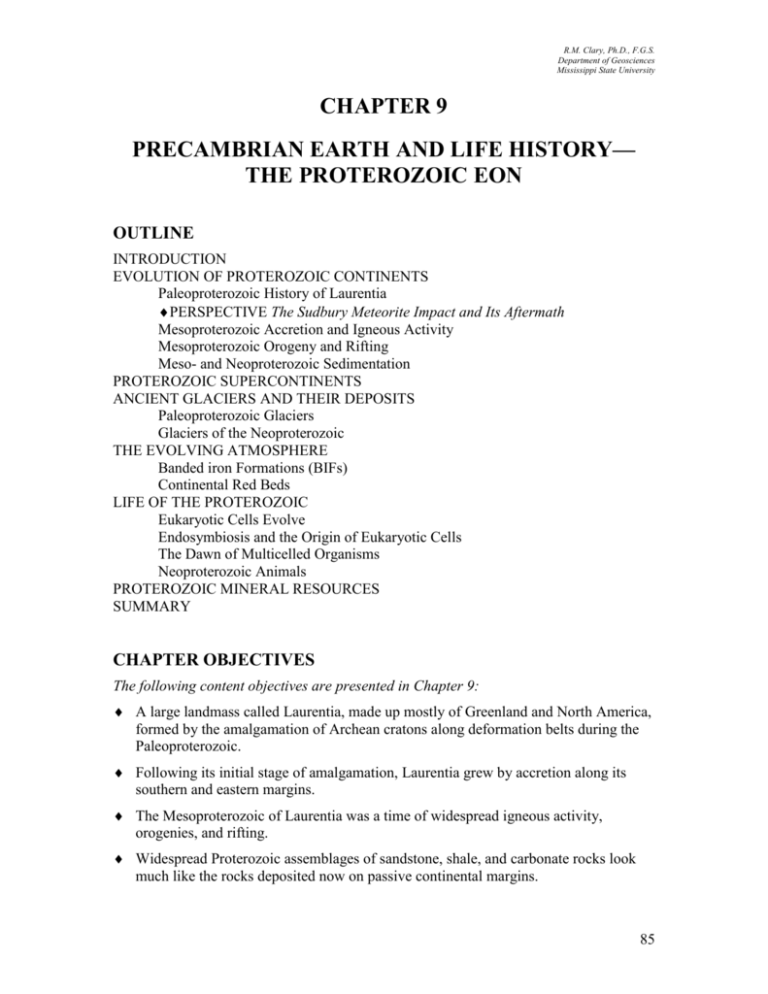
R.M. Clary, Ph.D., F.G.S. Department of Geosciences Mississippi State University CHAPTER 9 PRECAMBRIAN EARTH AND LIFE HISTORY— THE PROTEROZOIC EON OUTLINE INTRODUCTION EVOLUTION OF PROTEROZOIC CONTINENTS Paleoproterozoic History of Laurentia PERSPECTIVE The Sudbury Meteorite Impact and Its Aftermath Mesoproterozoic Accretion and Igneous Activity Mesoproterozoic Orogeny and Rifting Meso- and Neoproterozoic Sedimentation PROTEROZOIC SUPERCONTINENTS ANCIENT GLACIERS AND THEIR DEPOSITS Paleoproterozoic Glaciers Glaciers of the Neoproterozoic THE EVOLVING ATMOSPHERE Banded iron Formations (BIFs) Continental Red Beds LIFE OF THE PROTEROZOIC Eukaryotic Cells Evolve Endosymbiosis and the Origin of Eukaryotic Cells The Dawn of Multicelled Organisms Neoproterozoic Animals PROTEROZOIC MINERAL RESOURCES SUMMARY CHAPTER OBJECTIVES The following content objectives are presented in Chapter 9: A large landmass called Laurentia, made up mostly of Greenland and North America, formed by the amalgamation of Archean cratons along deformation belts during the Paleoproterozoic. Following its initial stage of amalgamation, Laurentia grew by accretion along its southern and eastern margins. The Mesoproterozoic of Laurentia was a time of widespread igneous activity, orogenies, and rifting. Widespread Proterozoic assemblages of sandstone, shale, and carbonate rocks look much like the rocks deposited now on passive continental margins. 85 R.M. Clary, Ph.D., F.G.S. Department of Geosciences Mississippi State University Plate tectonics, essentially like that occurring now, was operating during the Proterozoic and one or possibly two supercontinents formed. The presence of banded iron formations and continental red beds indicate that at least some free oxygen was present in the atmosphere. Extensive glaciation took place during the Paleoproterozoic and the Neoproterozoic. The first eukaryotic cells, that is, cells with a nucleus and other internal structures, evolved from prokaryotic cells by 1.2 billion years ago. Impressions of multicelled animals are found on all continents except Antarctica. Banded iron formations, as sources of iron ore, are important Proterozoic resources, as are deposits of copper, platinum, and nickel. LEARNING OBJECTIVES To exhibit mastery of this chapter, students should be able to demonstrate comprehension of the following: the important sequence of events in the evolution of Laurentia, including major orogenies and the Midcontinent rift Archean and Proterozoic styles of plate tectonics the evidence for Proterozoic glaciation episodes the evolution of the atmosphere the distribution, age, and origin of banded iron formations the evidence and significance of the first eukaryotic cells characteristics of eukaryotes, and the possible role of endosymbiosis in their development characteristics of Neoproterozoic animals types and geologic associations of Proterozoic ore deposits CHAPTER SUMMARY 1. The crust-forming processes that yielded Archean granite-gneiss complexes and greenstone belts continued into the Proterozoic but at a considerably reduced rate. Figure 9.1 Proterozoic Rocks 2. Paleoproterozoic collisions between Archean cratons formed larger cratons that served as nuclei, around which crust accreted. One large landmass so formed was Laurentia, consisting mostly of North America and Greenland. The collisions among plates formed several orogens. Sedimentary rocks in the Wopmay orogen record the opening and closing of an ocean basin, or Wilson Cycle. 86 R.M. Clary, Ph.D., F.G.S. Department of Geosciences Mississippi State University Some of the sedimentary rocks in the Wopmay organ consist of a sedimentary rock suite called a sandstone-carbonate-shale assemblage that forms on passive margins. Figure 9.2 Proterozoic Evolution of Laurentia Figure 9.3 The Wopmay Orogen and the Wilson Cycle (Active figure) Figure 9.4 Paleoproterozoic Sedimentary Rocks 3. Paleoproterozoic amalgamation of cratons, followed by Mesoproterozoic igneous activity, the Grenville orogeny, and the Midcontinent rift, were important events in the evolution of Laurentia. Figure 9.5 Rocks of the Grenville Orogen Figure 9.6 The Midcontinent Rift Figure 9.7 Proterozoic Rocks in the Western United States and Canada 4. Sandstone-carbonate-shale assemblages deposited on passive continental margins were very common by Proterozoic time. 5. Ophiolite sequences marking convergent plate boundaries are first well documented from the Neoarchean and Paleoproterozoic, indicating that a plate tectonic style similar to that operating now had become established. Figure 9.8 The Jormua Mafic-Ultramafic Complex in Finland 6. The supercontinent Rodinia assembled between 1.3 and 1.0 billion years ago, fragmented, and then reassembled to form Pannotia about 650 million years ago, which began fragmenting about 550 million years ago. Figure 9.9 Rodinia 7. Glaciers were widespread during both the Paleoproterozoic and the Neoproterozoic. Figure 9.10 Paleo- and Neoproterozoic Glaciers Figure 9.11 Proterozoic Glaciation Enrichment Topic 1. Snowball Earth Investigate the Snowball Earth hypothesis in more detail. Gabrielle Walker details the story of Paul Hoffman, who originally coined the phrase “Snowball Earth,” in Snowball Earth: the Story of a Maverick Scientist and His Theory of a Global Catastrophe That Spawned Life as We Know It (2004). The hypothesis rests on evidence of glaciers in tropical regions, only 11 degrees from the equator, such as Panama today. It is hypothesized that because tropical glaciers existed, it is likely that glaciers covered the landmasses of the entire globe. “Snowball Earth,” was repeated at least once more 700 million years ago, when glaciers were even closer to the equator. The plummeting temperatures were likely caused by a lack of carbon dioxide, which may have been utilized and removed by abundant plants. A large event—such as a volcanic eruption, a meteorite impact, or the sudden release of frozen methane deposits— would be needed to release carbon dioxide into the atmosphere. Science News, March 29, 1997 v.151 n.13 p.196. 87 R.M. Clary, Ph.D., F.G.S. Department of Geosciences Mississippi State University 8. Photosynthesis continued to release free oxygen into the atmosphere, which became increasingly rich in oxygen through the Proterozoic. 9. Fully 92% of Earth’s iron ore deposits in the form of banded iron formations (BIFs) were deposited between 2.5 and 2.0 billion years ago. Figure 9.11 Paleoproterozoic Banded Iron Formation (BIF) Enrichment Topic 2. Elements and Evolution The bulk of Earth’s surface is covered by ocean regions, where life is scarce. Although thinly-populated ecosystems do not lack in energy (sunshine), water, or the basic building blocks (carbon, hydrogen, oxygen, nitrogen), they are deficit in other elements needed to sustain life. Massive deposits of BIFs changed the environmental chemistry of the oceans. Whereas the oceans were rich in iron during the first half of Earth history, iron is scarce in oceans today. It is often called a limiting nutrient. Sulfur was also affected. Other changes in bioessential elements are more subtle, but the changing environment affected manganese, cobalt, nickel, copper, zinc, and molybdenum. Changes in the chemical composition of the ocean affected the biosphere as well. A. Anbar, “Elements and Evolution.” Science, December 5, 2008, v. 322, p. 1481-1483. 10. Continental red beds appeared about 1.8 billion years ago, and indicate that Earth’s atmosphere had enough free oxygen for oxidation of iron compounds. 11. Most of the known Proterozoic organisms are single-celled prokaryotes (bacteria). When eukaryotic cells first appeared is uncertain, but they were probably present by 2.1 billion years ago. Endosymbiosis is a widely accepted theory for their origin. Figure 9.12 Proterozoic Fossil Bacteria and Stromatolites Figure 9.13 Prokaryotic and Eukaryotic Cells Table 9.1 The Six-Kingdom Classification of Organisms Figure 9.14 The Three Domain Classification System Figure 9.15 The Oldest Known Eukaryote and Megafossil Figure 9.16 Proterozoic Fossils Figure 9.17 Endosymbiosis and the Origin of Eukaryotic Cells Enrichment Topic 3. Tracing Evolution to its Roots Microbiologist Mitchell Sogin traced human evolution back to the first organism that gave rise to humans. When he used DNA technology to trace the molecular evolution of today’s known species back to their origins, he was surprised to find out that our oldest animal evolutionary link is the sponge. Tracing DNA beyond the animal lineage yielded an even bigger surprise: Sogin discovered that animals are more closely related to fungi. McClintock, “This is Your Ancestor,” Discover, Nov. 2004 v.25 n.11 p.64-69. 12. Multicelled organisms were present by the Neoproterozoic, but the fossil record does not tell us how the transition took place. Figure 9.18 Single Celled and Multicelled Organisms 88 R.M. Clary, Ph.D., F.G.S. Department of Geosciences Mississippi State University 13. The first controversy-free fossils of animals come from the Ediacaran fauna of Australia and other locations. Animals were widespread at this time, but because all lacked durable skeletons their fossils are not common. Figure 9.19 The Ediacaran Fauna of Australia Figure 9.20 Ediacaran-type Fossils from Mistaken Point Formation of Newfoundland Figure 9.21 Neoproterozoic Fossils Enrichment Topic 4. Ediacaran Fauna. The Ediacaran fauna may provide the first glimpse of life after “Snowball Earth.” One species, Charnia, that consists of slender fronds 2 meters in length, is the longest Ediacaran fossil. Its presence between glacial deposits provides the first glimpse of megafauna after the melting of the glaciers. Narbonne & Gehling, Geology, January 2003, v.31 n.1 p.27-30. The Ediacaran fauna subdivided vertical space within a community, a characteristic known as epifaunal tiering. In Neoproterozoic Ediacaran communities, at least three tiers were present: a lower level 0-8 cm above the seafloor, an intermediate level 8-22 cm above the seafloor, and an upper level from 22 cm to as high as 120 cm. This structure is consistent with suspension feeders or organisms that absorb nutrients directly from the water. Clapham and Narbonne, Geology, July 2002, v.30 no7 p627-630. Enrichment Topic 5. The Cost of Diversity The diversity exhibited in faunas such as the Ediacaran is not without cost. Drew Allen, an ecologist at the University of California at Santa Barabara, calculated how much energy it costs to generate a new species. The answer is a staggering 1023 joules, more energy released by all the fossil fuels burned on the Earth in one year. Allen investigated foraminifera, one-celled plankton, and used both the body size of the organism and its metabolism’s dependence of temperature. Although the energy required for a new species is constant, species form more quickly at the equator. Discover, Sept. 2006, p. 14. 14. Most of the world’s iron ore production is from Proterozoic banded iron formations. Other important resources include nickel and platinum. Figure 9.22 Iron Mining from the Lake Superior Region LECTURE SUGGESTIONS Banded Iron Formations Help students to gain an understanding of the importance of banded iron formations. Banded iron formations represent a significant economic resource. Ninety percent of the world's iron ore (1 billion tons yearly) comes from these types of deposits. 89 R.M. Clary, Ph.D., F.G.S. Department of Geosciences Mississippi State University From the period of 2.0 to 1.8 billion years ago, it is estimated that 1014-15 tons of iron were precipitated. Have students calculate the rate of deposition of the iron deposits, as well as how long it will take at our current rate of consumption to deplete the iron ore. Diversity of Life in the Proterozoic Eon Emphasize that the fossil record is very incomplete, and have students hypothesize how much of the Proterozoic Eon’s life forms are actually represented as fossils. Before the advent of eukaryotic cells, reproduction was accomplished asexually. Once eukaryotic cells evolved, evolution proceeded fairly rapidly to the diversity seen in the Neoproterozoic fauna of the Ediacaran. Review the connections between sexual reproduction and speed of speciation. Ediacaran Fauna Investigate the earliest animals of the Ediacaran fauna, and have students predict the ecosystems in which these organisms lived. Are the animals all herbivores? How do students predict the animals acquired food? Do these same organisms exist today? If not, why? Why aren’t Edicaran fauna as well-preserved as some later animal specimens? Relationship of the Precambrian to Geologic Time At the end of this chapter, you may want to remind students of the enormity of time that is contained in the Precambrian. Visual aids, such as adding machine tape or toilet paper timelines, are great tools to help students visualize just how much time has passed before the onset of our current eon, the Phanerozoic. Ask students to recall the great events of the Archean (development of tectonics, origin of prokaryotic life, photosynthesis), and the Proterozoic (modern tectonics, eukaryotic cell, multicelled life, oxygenated atmosphere). Then ask students to list some of the events that they believe will take place in the Phanerozoic Eon (origin of vertebrates, fish, amphibians, reptiles, mammals, insects, terrestrial plants, humans). How do these two lists compare—Precambrian versus Phanerozoic Eon—in time, as well as in events? CONSIDER THIS 1. According to the plate tectonic theory, what should be the orogenic belt-shieldcraton structure of all of the continents? 2. The Belt Basin in northern Idaho and western Montana was the site of the accumulation of a phenomenal amount of silt and clay sized sediment. Have students calculate the amount of time it would take to deposit 42,000 feet of sediment given deposition rates ranging from 1 to about 5 mm/year. 3. Has the location of BIF deposits affected the industrial revolution in the U.S.? Has this location affected the development of the automobile industry in the U.S.? 90 R.M. Clary, Ph.D., F.G.S. Department of Geosciences Mississippi State University IMPORTANT TERMS banded iron formation (BIF) continental red beds Ediacaran fauna Endosymbiosis eukaryotic cell Grenville orogeny Laurentia Midcontinent rift multicelled organism Orogen Pannotia Rodinia sandstone-carbonate-shale assemblage supercontinent Wilson cycle SUGGESTED MEDIA Videos 1. Nature: Triumph of Life: The Mating Game, PBS Home Video 2. Life on Earth: The Infinite Variety, BBC Video 3. Miracle Planet: Snowball Earth, The Science Channel 4. Nature: Triumph of Life: The Four Billion Year War, PBS Home Video Slides and Demonstration Aids 1. The Origins of Life, slide set, Educational Images, Ltd. 2. Evolution of Life on Earth, slide set, Educational Images, Ltd. CHAPTER 9 - ANSWERS TO QUESTONS IN TEXT Multiple Choice Review Questions 1. 2. 3. 4. a c e b 5. 6. 7. 8. c c a d 9. c 10. a Short Answer Essay Review Questions 11. The first fossils that all paleontologists agree are animals are found in the Ediacaran fauna of Australia and other continents (except Antarctica), and these are about 545- to 600-million-years old. Their fossils are rare because the animals were soft bodied and so did not fossilize easily. 12. The Midcontinent rift is a long narrow trough with two branches. One branch extends southeast as far as Kansas, and one extends southeasterly through Michigan into Ohio. The rifting began about 1.1 billion years ago Although not all geologists agree, many think that the Midcontinent rift is a failed rift where Laurentia began splitting apart. The central part of the rift contains numerous overlapping basaltic lava flows. Along the rift’s margins, conglomerate was deposited in large alluvial fans that grade into sandstone and shale with increasing distance from the sediment source. 91 R.M. Clary, Ph.D., F.G.S. Department of Geosciences Mississippi State University 13. The endosymbiosis theory for the origin of eukaryotic cells states that eukaryotes formed by a complex, sequential incorporation of symbiotic prokaryotes into an original prokaryotic host. The evidence comes from studies of living eukaryotic cells containing internal structures called organelles. The organelles have their own genetic material and synthesize proteins just as prokaryotic cells do. These organelles, with their own genetic material and protein-synthesizing capabilities, are thought to have been free-living bacteria that entered into a symbiotic relationship, eventually giving rise to eukaryotic cells. 14. Proterozoic banded iron formations and continental red beds contain iron oxides, which indicate the presence of oxygen in the atmosphere. The Archean had little or no free oxygen but abundant carbon dioxide. Iron is a high reactive element, and in an oxidizing atmosphere it combines with oxygen to form rustlike oxides that do not dissolve in water. If oxygen is absent, iron is easily taken into solution and can accumulate in large quantities in oceans. Therefore, the presence of the BIFs and red beds indicate that oxygen was present in the Proterozoic, although it was not in the Archean. 15. The evolution of Laurentia was long, complex, and is still not fully understood. However, it involves the amalgamation of cratons, the accretion of volcanic arcs and oceanic terranes, and extensive plutonism, metamorphism, and volcanism. Between 2.0 and 1.8 billion years ago, Archean cratons collided and formed several orogens 16. A Wilson cycle, named for Canadian geologist J. Tuzo Wilson, is a full cycle recording the opening and closing of an ocean basin. There is evidence of Wilson cycles in Precambrian rocks. Some geologists think the Wopmay orogen represents a Wilson cycle. Evidence for the opening of an ocean basin include sandstonecarbonate-shale assemblages (a passive margin sedimentary sequence), while ophiolites indicate subduction, or the closing of an ocean basin. 17. Using the principle of uniformitarianism, you should look for the known features of glacial movement in addition to the tillite, such as varves, dropstones, and polished and striated bedrock. 18. The sedimentary assemblages of sandstone-carbonate-shale represent a passive continental margin. Passive margin deposits are rare or absent in Archean rocks, but they became common during the Proterozoic and thereafter. 19. The Archean was characterized by the origin of granite-gneiss terrains and greenstone belts that were shaped into cratons. Although these rock associations formed in the Proterozoic, they did so at a considerably reduced rate. Archean rocks are metamorphic, while Proterozoic rocks are unaltered or nearly so. 92 R.M. Clary, Ph.D., F.G.S. Department of Geosciences Mississippi State University Apply Your Knowledge 1. 4000 meters = 4,000,000 mm, 1.45 billion – 850 million = 600 million years. So the sedimentation rate = 4,000,000/600,000,000 = 0.0067 mm/year. This is unlikely to represent the actual rate of sediment accumulation because it does not take erosion into account. 2. If we were to look for signs that oceans and continents formed through tectonic activity, such as a Wilson cycle that records the opening and closing of an ocean basin, we should look for evidence of passive continental sedimentation (sandstone-carbonate-shale assemblages) that mark the opening of an ocean basin, and we should look for evidence of subduction (ophiolites) that mark the closing of an ocean basin. 3. On the upper and lower surfaces of the Purcell sill are metamorphosed zones, or light-colored marble. This indicates that the sill was emplaced into existing limestone (contact metamorphism). Slower cooling in the middle of the sill would yield larger crystals than the upper and lower boundaries, which would cool quicker in contact with existing sedimentary rocks. In addition, we can use the principle of inclusions. If the Purcell sill was a buried lava flow, we should see signs of erosion on its upper surface, and the inclusion of some of the diorite in the upper layers of the Siyeh Limestone. Therefore, the Purcell sill is YOUNGER than the Siyeh Limestone, and if it is 1.45 billion years old, the Siyeh Limestone must be older than 1.45 billion years. 4. a. The Vishnu Schist appears older than the Zoraster Granite. The schist was metamorphosed before the granite was emplaced. We can use the principle of cross-cutting relationships, and our knowledge of metamorphism to determine this. (If the schist was younger than the granite, the granite should also have been subjected to metamorphism.) b. The uncomformity present is a noncomformity, in which metamorphic or igneous rocks underlie younger sedimentary rocks. c. The unconformity between the Grand Canyon supergroup and the Tapeats sandstone is an angular unconformity because the Grand Canyon supergroup is at an angle to the overlying Tapeats. d. The sequence of the Tonto Group (sandstone-shale-limestone) appears to represent a transgression, with the shoreline migrating toward the continent. This will yield deeper water and sedimentation patterns in the same area as the shoreline migrates toward the craton. 93
